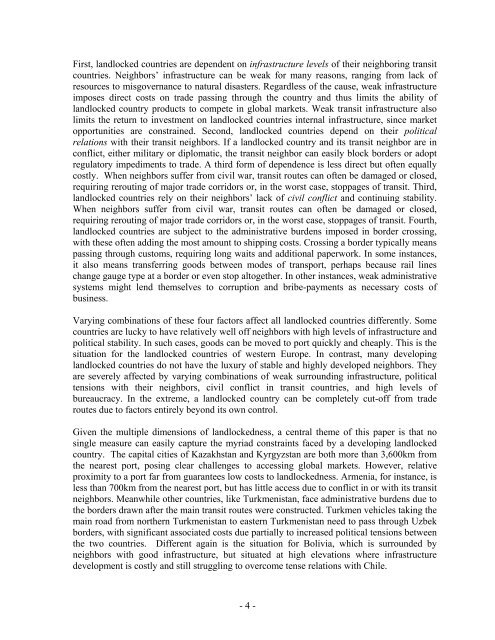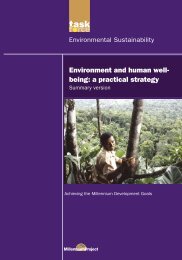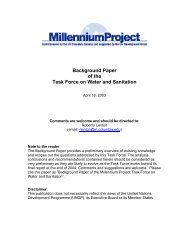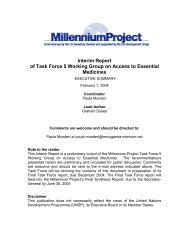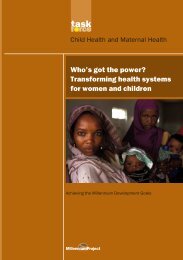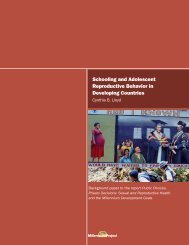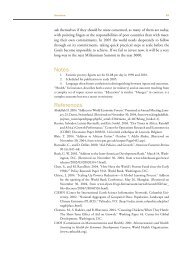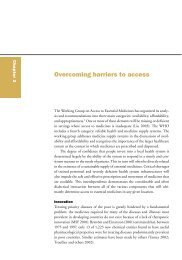the challenges facing landlocked developing countries: a case study ...
the challenges facing landlocked developing countries: a case study ...
the challenges facing landlocked developing countries: a case study ...
Create successful ePaper yourself
Turn your PDF publications into a flip-book with our unique Google optimized e-Paper software.
First, <strong>landlocked</strong> <strong>countries</strong> are dependent on infrastructure levels of <strong>the</strong>ir neighboring transit<br />
<strong>countries</strong>. Neighbors’ infrastructure can be weak for many reasons, ranging from lack of<br />
resources to misgovernance to natural disasters. Regardless of <strong>the</strong> cause, weak infrastructure<br />
imposes direct costs on trade passing through <strong>the</strong> country and thus limits <strong>the</strong> ability of<br />
<strong>landlocked</strong> country products to compete in global markets. Weak transit infrastructure also<br />
limits <strong>the</strong> return to investment on <strong>landlocked</strong> <strong>countries</strong> internal infrastructure, since market<br />
opportunities are constrained. Second, <strong>landlocked</strong> <strong>countries</strong> depend on <strong>the</strong>ir political<br />
relations with <strong>the</strong>ir transit neighbors. If a <strong>landlocked</strong> country and its transit neighbor are in<br />
conflict, ei<strong>the</strong>r military or diplomatic, <strong>the</strong> transit neighbor can easily block borders or adopt<br />
regulatory impediments to trade. A third form of dependence is less direct but often equally<br />
costly. When neighbors suffer from civil war, transit routes can often be damaged or closed,<br />
requiring rerouting of major trade corridors or, in <strong>the</strong> worst <strong>case</strong>, stoppages of transit. Third,<br />
<strong>landlocked</strong> <strong>countries</strong> rely on <strong>the</strong>ir neighbors’ lack of civil conflict and continuing stability.<br />
When neighbors suffer from civil war, transit routes can often be damaged or closed,<br />
requiring rerouting of major trade corridors or, in <strong>the</strong> worst <strong>case</strong>, stoppages of transit. Fourth,<br />
<strong>landlocked</strong> <strong>countries</strong> are subject to <strong>the</strong> administrative burdens imposed in border crossing,<br />
with <strong>the</strong>se often adding <strong>the</strong> most amount to shipping costs. Crossing a border typically means<br />
passing through customs, requiring long waits and additional paperwork. In some instances,<br />
it also means transferring goods between modes of transport, perhaps because rail lines<br />
change gauge type at a border or even stop altoge<strong>the</strong>r. In o<strong>the</strong>r instances, weak administrative<br />
systems might lend <strong>the</strong>mselves to corruption and bribe-payments as necessary costs of<br />
business.<br />
Varying combinations of <strong>the</strong>se four factors affect all <strong>landlocked</strong> <strong>countries</strong> differently. Some<br />
<strong>countries</strong> are lucky to have relatively well off neighbors with high levels of infrastructure and<br />
political stability. In such <strong>case</strong>s, goods can be moved to port quickly and cheaply. This is <strong>the</strong><br />
situation for <strong>the</strong> <strong>landlocked</strong> <strong>countries</strong> of western Europe. In contrast, many <strong>developing</strong><br />
<strong>landlocked</strong> <strong>countries</strong> do not have <strong>the</strong> luxury of stable and highly developed neighbors. They<br />
are severely affected by varying combinations of weak surrounding infrastructure, political<br />
tensions with <strong>the</strong>ir neighbors, civil conflict in transit <strong>countries</strong>, and high levels of<br />
bureaucracy. In <strong>the</strong> extreme, a <strong>landlocked</strong> country can be completely cut-off from trade<br />
routes due to factors entirely beyond its own control.<br />
Given <strong>the</strong> multiple dimensions of <strong>landlocked</strong>ness, a central <strong>the</strong>me of this paper is that no<br />
single measure can easily capture <strong>the</strong> myriad constraints faced by a <strong>developing</strong> <strong>landlocked</strong><br />
country. The capital cities of Kazakhstan and Kyrgyzstan are both more than 3,600km from<br />
<strong>the</strong> nearest port, posing clear <strong>challenges</strong> to accessing global markets. However, relative<br />
proximity to a port far from guarantees low costs to <strong>landlocked</strong>ness. Armenia, for instance, is<br />
less than 700km from <strong>the</strong> nearest port, but has little access due to conflict in or with its transit<br />
neighbors. Meanwhile o<strong>the</strong>r <strong>countries</strong>, like Turkmenistan, face administrative burdens due to<br />
<strong>the</strong> borders drawn after <strong>the</strong> main transit routes were constructed. Turkmen vehicles taking <strong>the</strong><br />
main road from nor<strong>the</strong>rn Turkmenistan to eastern Turkmenistan need to pass through Uzbek<br />
borders, with significant associated costs due partially to increased political tensions between<br />
<strong>the</strong> two <strong>countries</strong>. Different again is <strong>the</strong> situation for Bolivia, which is surrounded by<br />
neighbors with good infrastructure, but situated at high elevations where infrastructure<br />
development is costly and still struggling to overcome tense relations with Chile.<br />
- 4 -


